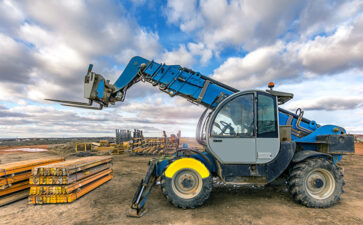A Safety-First Philosophy For the Construction Space
A busy construction worksite is fraught with multiple safety and logistical concerns that need to be identified and managed daily. Experienced construction operators and project managers might well equate the management of logistics on a live construction site to a constantly evolving kaleidoscope: Priorities and new developments must mesh seamlessly with pre-determined production plans in real time. And these plans must adhere strictly to industry standards and best practices—all managed with the highest levels of acumen. Problems that arise must be swiftly addressed—without incident. From on-time materials deliveries, to supply storage and maintenance issues, to project guideline adherence, environmental compliance, and effective budget allocation, there are a plethora of construction site elements that contribute to a responsible construction site “playbook.”
It’s not surprising that the role of a construction site project manager is one that requires excellent management skills—and these skills must be supported by a strong administration team that chooses the right technology and tools for the job. Every element of the construction process—whether it involves a single site residential home build or an exhaustive, multi-month/multi-year commercial development—requires flawless attention to detail to ensure an efficient outcome. The ability to manage resources, maximize manpower output, and ensure a streamlined worksite flow (in sync with fiscal guidelines) is no small task. And while each “cog” in this worksite management chain is pivotal, none are as essential as onsite worker safety.
And, not ironically, the construction and development space, across the decades, has long been identified as one of the most vulnerable industries when it comes to ensuring laborer safety and well-being because of the highly rigorous nature of the work environment. Dealing with large moving vehicles, heavy equipment, and a host of raw supplies—in addition to often working either underground or from an elevated location—only adds to the necessity for heightened awareness regarding worker safety and injury reduction.
The statistics say it all
According to a recent article in BigRentz.com, “Even with advances in safety protocols, equipment and training within the construction sector, the industry is still known for its persistently high rates of deaths and injuries.” The article goes on to relay that “the rates of construction worker deaths are so high that the industry has the highest amount of workplace deaths. This emphasizes the clear need for a continued push for on-the-job safety improvements for those working in the construction industry.”
And according to Injury Facts, an industry awareness-building and statistical arm of the National Safety Council (America’s leading non-profit safety advocate), the construction space “experienced the most workplace deaths” in recent years. Again, this data underscores the need for building development managers and operators to make on-the-job safety a top priority.
What’s the antidote? While no industry is completely foolproof, and even the best laid plans can go astray, the key to efficient worksite management is advance planning. This includes, in addition to a host of other strategic factors, turning to the most reliable and trusted technology solutions. Chief among the need for ample technology solutions is the proper use of transportation vehicles and tools.
Why is transportation efficiency so important?
According to ConstructConnect, falls (likely from high worksite locations and scaffolding) present the highest fatality risk for construction workers, but this isn’t the only prevalent cause. According to the same source, falls equate to approximately 40 percent of the mortality risk, while transportation incidents equate to 27 percent of the risk. Additionally, the U.S. Occupational Safety and Health Administration (OSHA) ranks vehicle-related injury as one of the top three risks, citing warnings to construction workers that “if vehicle safety practices are not observed at your site, you risk being pinned between construction vehicles and walls, struck by swinging backhoes, crushed beneath overturned vehicles, (or) you risk being struck by trucks or cars.”
And yet the use of construction vehicles—often in large numbers—is absolutely essential to logistical operations, especially on a large commercial or civic engineering development project. But there are technology resources at the ready avail of project managers and transportation operators that can help to vastly reduce the risk of injury from construction vehicles and heavy equipment.
Polyurethane tire or “foam fill” technology can play a pivotal role in helping to make large transportation trucks and utility vehicles and earthmoving equipment (such as bulldozers, telehandlers, excavators and more) safer. An unexpected tire flat on the job presents a major safety risk. If the vehicle or equipment is working on a gradated or angled hillside, the vehicle is at risk for hazardous tip-over, which can throw drivers out of the cab or inadvertently crush other nearby workers. A sudden flat even on a uniform surface instantly undermines the stability of the vehicle, and any unanticipated situation of this kind is fraught with potential safety problems—not to mention costing operators heavily by potentially bringing the entire job site to an abrupt halt.
And tire flats—without the proper preventative tire technology—are not a question of “if” but “when.” Carlisle TyrFil has been the leading innovator of Tire Flatproofing technology solutions for nearly six decades and can help to play a preventative role. Unlike pneumatic air-filled tires, foam filled tires like TyrFil pumps a polyurethane fill into the tire carcass that cures within 24 hours making the tire virtually immune to unexpected punctures from worksite debris, including nails, sharp rocks, glass, rebar and more. Using TyrFil, operators can essentially rule out transportation equipment breakdowns and risks that are tire flat-related—improving the safety equation on the construction job site immeasurably.
Additionally, the use of foam fill tires is far preferable—from an ergonomic perspective—for vehicle drivers because it spares them the rough, jarring and bumpy ride that is typical with a vehicle riding on solid aperture tires. If the equipment that the worker is driving – typically for 5-6 days a week, 12 months out of the year – is equipped with solid tires vs. polyurethane-filled pneumatics, the operator may be exposed to a jolting ride phenomenon referred to as “Solid Shock.” Daily exposure to the repetitive harsh impact of G-force vibration transmission to equipment and operators can result in a condition called Whole Body Vibration (or “WBV”), which may cause headaches, lower back pain and fatigue. Prolonged exposure may even cause more serious and sustained muscular/skeletal and neurological impact.
In today’s current work climate, it is more incumbent than ever for builders and developers to make prudent and strategic decisions that make worker safety “job number one.” Not only is it mandated from a regulatory perspective, but a safety-first philosophy is simply proper management and demonstrates to employees and the industry a strong corporate social responsibility commitment.
Carlisle TyrFil is proud to partner with the construction and commercial/industrial transportation industries and other transportation-related business sectors to ensure smoother, safer and more effective Off-the-Road (OTR) vehicle tire protocols and handling.
For additional information, please visit www.carlisletyrfil.com to learn more about the many advantages of foam fill tire flatproofing.


